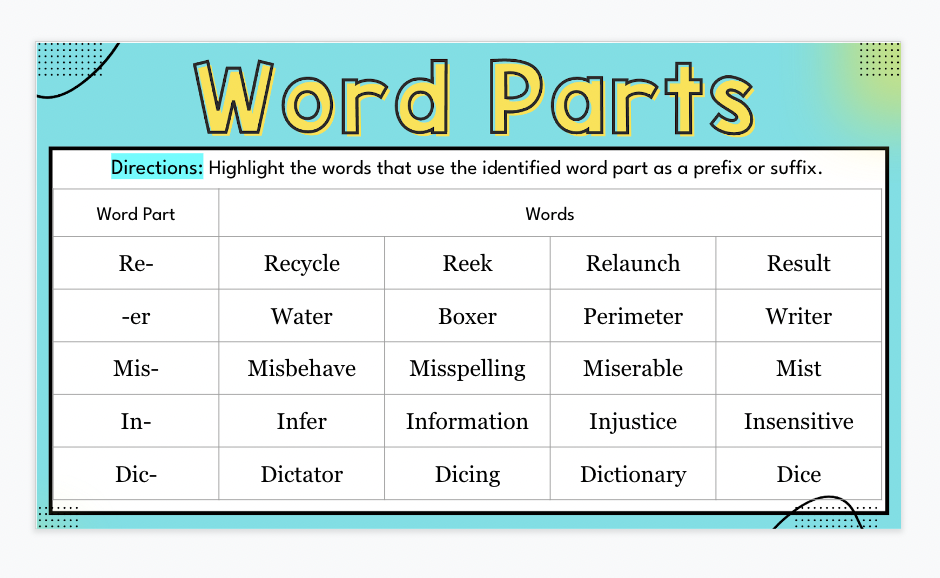How to Teach Prefix, Roots, and Suffixes
A person I know (they are going to remain nameless so I don't hurt their feelings) had a week off of work.
What did they do with their week off…
…They put together a puzzle that was all white.
I don't know about you, but that sounds like my personal hell. 🤣 (I looked it up. The puzzle is actually called Pure White Hell, so it’s not just me. I linked it in case you’re into that kind of thing.)
I have never been one who looks forward to sipping on a cup of coffee while putting one together. I just don’t find it fun or relaxing. I'm more of a lay in my bed and read a trashy book kind of girl.
However, it’s a different story when we are talking about words.
Maybe it’s because I missed out on this type of information when I was younger. (I was taught to read by using the Whole Language Approach.)
But ever since I was introduced to morphology in college, I love to see how words were created and how the pieces fit together to create new meanings.
I mean, etymology.com is one of favorite websites!
Not only is it fun (probably just my opinion), but learning morphology can be time well spent in your classroom because it unlocks the structures and meanings within words.
It is like handing your students a secret decoder ring that allows them to unlock the meaning behind complex words.
With morphology, your students can understand the hidden messages in words that seem intimidating or confusing. In turn, this increases a student's reading comprehension by building a strong vocabulary base.
Just think— if a student knows that the prefix im- means not they are more likely to understand the meaning of unknown words that contain this prefix like immoral or impassive.
These unknown words are like a small puzzle that can be broken into pieces in order to determine their meaning.
How much fun is that?!
If you want to join in on the fun, here are some tips on how to teach morphology.
1.Teach a combination of prefixes, roots/base words, and suffixes in one lesson.
I want students to quickly see how words are formed, so I teach four prefixes, four roots/base words, and two suffixes each lesson.
I provide them with the word part, the meaning, and easy to understand examples.
Immediately, students can start to connect the pieces in order to make new words. As we add on lessons, they can combine previous word parts to the new word parts!
2. Provide time for basic practice
After we go over the meaning of the word parts, I allow my students time to grasp the basic understanding by giving them a digital matching activity and Quizlet. Once they have the meanings down, we can work on taking their understanding to the next level.
3. Create blending activities
For this activity, I give students five sentences. Each sentence has a missing word and a clue. The clue is one of the word parts that we have learned in class. The students have to use that word part to create a word that would make sense in the sentence. To help the students I provide them with a bank of other word parts they can use to combine their clue with.
The goal of this activity is to provide students with practice combining the word parts together in order to create a new word with the same basic meaning.
4. Provide opportunities for discovery
To begin with, I have students highlight words that use the word part correctly. For example, just because a word starts with re, that doesn’t mean it’s used as a prefix.
After they have grasped this understanding, later lessons are all about students coming up with their own words using the word parts, highlighting the different word parts (prefix, root, suffix), and selecting one of the words to use in a unique sentence.
This activity solidifies their understanding of how word parts work together to create meaning.
5. Dig deeper
From each lesson, I like to pick out two word parts that students can expand on through the use of the Frayer Model. Using the model they write the meaning, come up with three example words, draw an image to help them remember the meaning, and write a sentence with one of their example words.
6. Create a tiered assessment
After we complete the activities, I like to provide my students with an assessment to monitor their understanding of the word parts.
Once you have the basics down, you can transition into teaching vocabulary words. (Check out this blog post for more information.) As you teach the vocabulary, you can point out the word parts and how they build the meaning of the new words.
Want to get started?
Here are some resources to help you!
Morphology Unit on TpT
You can use the 10 lessons in this resource to help your students learn 100 new word parts!
ELA UNLIMITED
Love this? Want more lessons and other creative and engaging resources? Try out ELA Unlimited!
ELA Unlimited Members, click the button for instant access to the 15 lessons! 👇
Want to try it out?
Get a FREE Week of Lessons!
Just fill out the form and you will be directed the Google folder.











